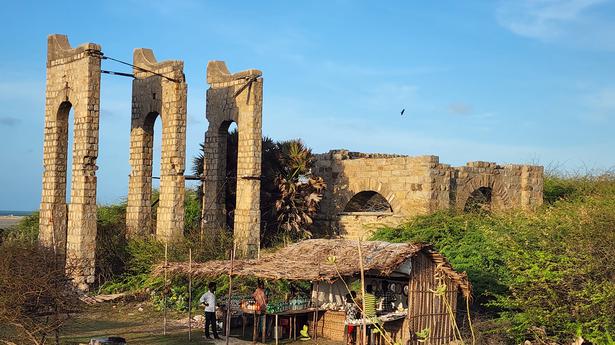It is working to expedite plans to reconstruct the 18-km railway line between Rameswaram and Dhanushkodi
It is working to expedite plans to reconstruct the 18-km railway line between Rameswaram and Dhanushkodi
Nearly 60 years after Dhanushkodi was wiped out by a devastating cyclone in 1964, the Indian Railways is working to expedite plans to revive this ghost town by reconstructing the 18-km railway line between Rameswaram and Dhanushkodi.
The Railways has begun the process of acquiring land for the ₹733-crore project, for which the foundation stone was laid by Prime Minister Narendra Modi in 2019. About 28.6 hectares are forest land and 43.81 hectares belong to the State government, while 3.66 hectares are privately held.
The ruins of the abandoned station, which have become the identity of the town over the past six decades, would be razed to make way for the new station, Madurai Division’s Assistant Executive Engineer Anand told The Hindu. “The ruins will have to be removed…We can’t keep it as a heritage site also, simply because the new railway line is proposed to go through there,” he said.
The ruins of the old station and the nearby area are also home to about 300 families living in makeshift houses without basic amenities. Mr. Anand said this was an “encroachment” and these families will need to vacate the land. This land, he said, used to be railway land, but was taken over by the district administration post the cyclone, and now, the Railways will re-acquire it.
According to the draft plan, the area where these families are living will form the yard of the new Dhanushkodi Railway Station, on the tip of Pamban Island, separated from the mainland by the Palk Strait.
The cyclone had washed away the Rameswaram-Dhanushkodi rail track along with a train and other infrastructure, leaving over 100 people dead and bringing to a halt a train service that provided a vital link via sea between Mandapam in India and Colombo in Sri Lanka, which was just 18 km away.
Once the requisite approvals have been obtained, the project would take around 18 months to be completed, and is expected to give a new lease of life to Dhanushkodi through easier access. Mr. Anand said about 20,000 tourists were expected to visit Rameswaram by 2041, and a large chunk of them were likely to visit Dhanushkodi as well.
While the villagers are uncertain of what is in store for them and how the relocation would work out, they believe Dhanushkodi should be connected with the rest of the country, especially given its cultural and religious significance. Within the dilapidated station is a small temple, where visitors could see and touch one of the famed ‘floating stones’ which were used to construct the Ram Setu, as per Hindu mythology.
“They have not been able to bring electricity and other basic amenities to the area for decades. How will they bring a railway line?” asked Dhanushkodi resident Karipaswami, who lost his entire family in the cyclone, and survived only because he was in Rameswaram.
“It will be good for Dhanushkodi if the railway line materialises…But there has been no development in the area for decades,” he added.
According to the proposal which is awaiting approval, an 18-kilometre line will be built between Rameswaram and Dhanushkodi – 5 km at ground level and the rest elevated track. The single line will be electrified and connected to the broad gauge.
The proposed rail line from Rameswaram will have three halt stations and one terminal station.








